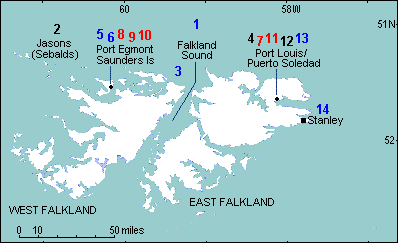First European
Sightings and Landings - Claims
for the first sightings of these uninhabited islands
included the Italian Amerigo Vespucci in 1502
and the expedition of Portugese-born Ferdinand Magellan in
1520.
Thereafter three firsts are generally accepted - Capt John
Davis made the first British sighting in 1592,
Dutchman Sebald de Weert first accurately plotted the
westerly Jason
Islands
in 1600,
and the first British landing was made in 1690
on the north coast by Capt John Strong who
named Falkland
Sound after
Lord Falkland of the Admiralty.
Spanish Control
- The 1713
Treaty of Utrecht confirmed Spain's continued control of
her traditional territories in the Americas, including
the offshore islands, but by now the French, many from
St. Malo were visiting the islands from which they
received the name Les Iles Malouines, subsequently the
Spanish Islas Malvinas. In the 1740's,
Admiral Lord Anson, back from his voyage around the
world recommended them as a naval base because of their
strategic position near Cape Horn.
French and
British
Settlement
- The first settlement was established in 1764
at
Port Louis
in Berkeley Sound by the French under Antoine de
Bougainville, who claimed the colony in the name of the
King of France, a step which brought strong protests
from allied Spain. Next
year
British Captain John Byron arrived to survey the north
coast, went ashore on Saunders Island off West Falkland
and in turn claimed the islands for Britain, naming
Port Egmont
before sailing away. Captain John McBride followed him
there in 1766
to set up a permanent colony, and that same
year
tried to eject the French from Port Louis, but unknown
to both of them, de Bougainville had already sold out to
Spain.
Spanish Colony
- De
Bougainville formally handed over the French colony in
1767
and Port Louis was renamed Puerto
Soledad.
A Spanish governor was appointed under the
Captain-General of mainland Buenos Aires, but both the
British on West Falkland and Spanish on East Falkland
carried on until 1769
when each tried to get the other to leave. In 1770,
on orders from Buenos Aires, five Spanish ships with
1,400 troops arrived and the small marine garrison at
Port Egmont was forced to leave in a move which nearly
led to war between the two countries. After intensive
negotiations Spain agreed in 1771
to Britain returning to Port Egmont, but reserved the
right to sovereignty. She also claimed Britain had
secretly agreed to pull out and indeed the settlement
was abandoned three years later in
1774.
Until the early
19th century,
the Falklands remained the Spanish colony of Islas
Malvinas.
Argentine Claim and
Possession -
Following independence from Spain in 1816,
the future state of Argentina laid claim to the previous
colonial territories, and in 1820
sent
a frigate to take possession of the Falklands. In
1826,
Louis Vernet of French origin established himself and a
number of colonists at Puerto Soledad to develop
fishing, farming and trade, and as governor from
1828 attempted
to control the widespread sealing. Waking up to
developments, Britain's consul general in Buenos Aires
protested in 1829
against the appointment of a governor and re-asserted
old claims to sovereignty.
United
States and British
Involvement - In 1831,
after arresting American sealers accused of poaching,
Louis Vernet sailed in one of them for Buenos Aires
where the captain was to stand trial. In reprisal, the
US warship "Lexington" arrived off Puerto Soledad,
destroyed the fortifications, arrested some of the
people and declared the islands free of government
before sailing away. Argentina and the United States
argued furiously over each other's high-handed
behaviour, and next year a new governor was appointed
but then murdered by rebellious colonists. As Argentine
forces attempted to restore order, Royal Navy warships
"Clio" and "Tyne" under the command of Captain Onslow
arrived in early 1833,
forced them to leave and claimed the Falklands for
Britain. Argentina protested strongly, but the British
Government maintained that all rights to sovereignty
were retained during the 1770 negotiations with Spain.
British Colonisation
- Britain
later started to settle the islands and formally
declared a colonial administration in
1842,
although Argentina continued to press her claim and from
the 1960's on,
with increasing vigour. Stanley
was established in 1845. By this time, Britain's right
to ownership rested mainly on her peaceful and
continuous possession over a long period of time, and
when serious negotiations began, they became dominated
by the islander's desire to remain British.
Argentine Claims
- After a period of Argentine lobbying, the United
Nations passed Resolution 2065 in 1965
specifying the Falklands/Malvinas as a colonial problem,
and calling on Britain and Argentina to find a peaceful
solution. Talks continued on and off for the next
seventeen years under both British Labour and
Conservative Governments. Britain initially appeared
flexible over the question of sovereignty, and by
1971
the Argentines were agreeing to concentrate on economic
development and support, but thereafter, both side's
position hardened. The Argentines would accept nothing
less than full sovereignty and in late
1980
the islanders rejected the one remaining solution of
lease-back for a fixed period. On the road to war,
Argentina set up a scientific base on Southern Thule in
the South Sandwich Islands in 1976
and
stayed put, and in 1982
her forces found themselves about to land on South
Georgia and to invade and hold the Falklands themselves.
 Summary
of Early Falklands History
Summary
of Early Falklands History